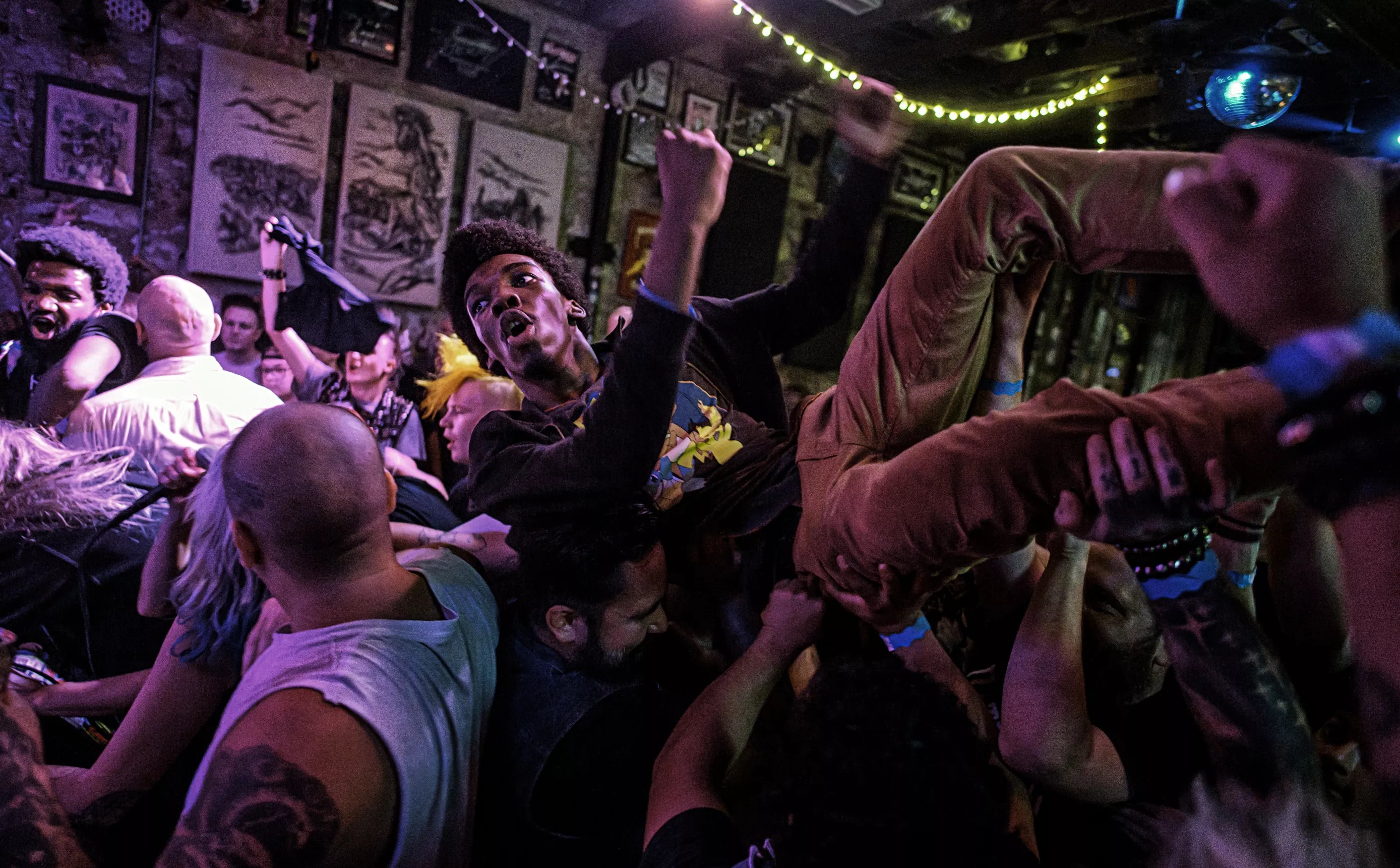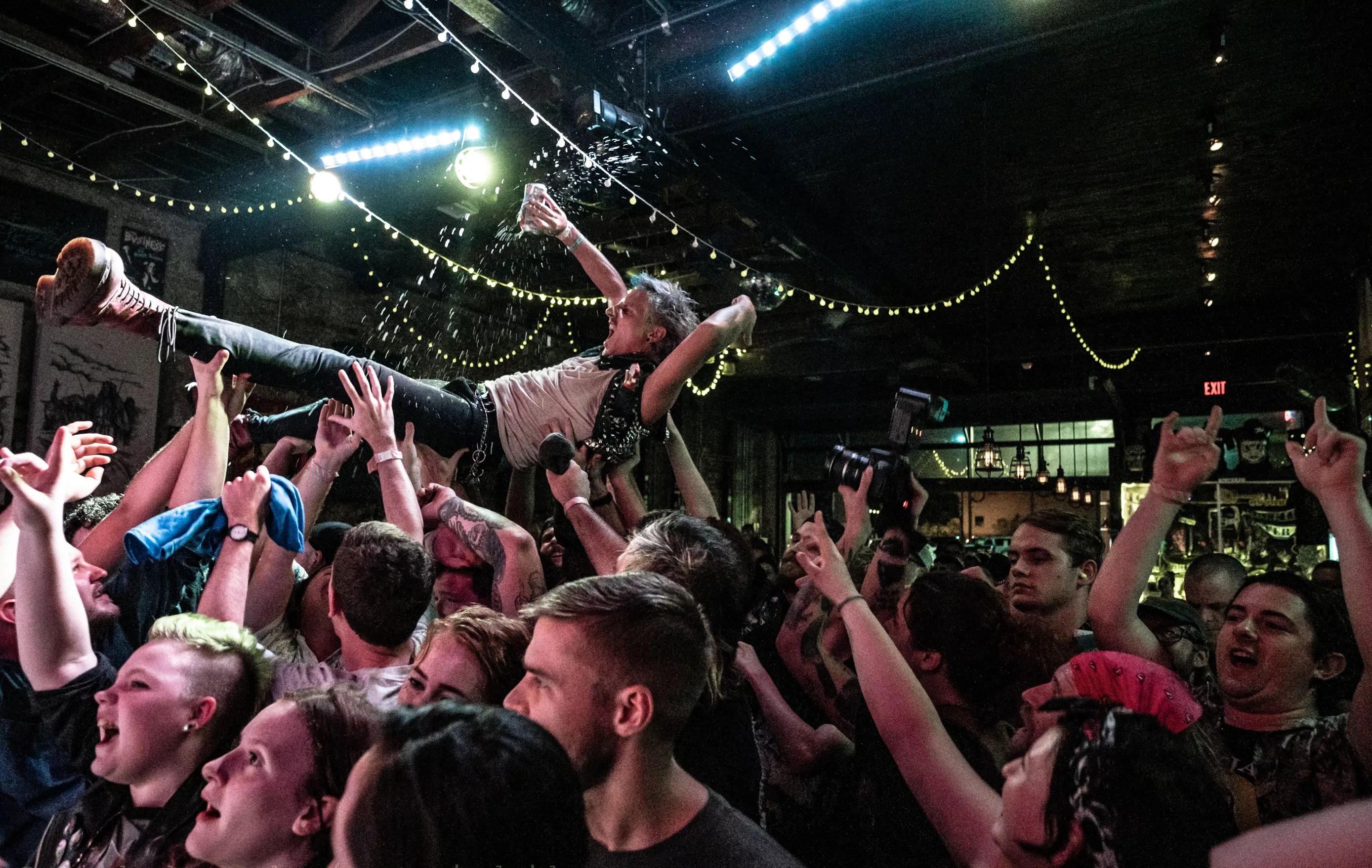
Mike Brooks

Audio By Carbonatix
Punk and metal are commonly perceived as two separate genres, but between the two is an important nexus that remains largely overlooked.
For as long as metal and punk have existed, they have built on each other, opening new worlds with new possibilities that are still being explored to this day.
Metal bands like Black Sabbath and Saint Vitus gave hardcore punk bands like Black Flag and Flipper a blueprint to build and expound on a sludgy, slow tempoed style, which in turn influenced metal bands like Neurosis, the Melvins and Eyehategod. Crust punk bands like Crass and Antisect had a wretched, grating style that became a crucial precursor to grindcore and death metal bands like Napalm Death and Carcass.
We recently ranked the best metal albums from North Texas and thought we’d take a look at some of the best punk albums to come from DFW. Y’know, in a yin and yang sort of way.
10. Riverboat Gamblers, To the Confusion of Our Enemies (2006)
In the early 2000s, pop-punk encountered something of a golden age as bands like Jimmy Eat World brought it to a more commercial frontier. This paved the way for bands with a too-sweet sound, like Fall Out Boy and Motion City Soundtrack, but this tide also lifted bands like Anti-Flag and The Ataris, who took on a more traditional interpretation of the genre.
This year, make your gift count –
Invest in local news that matters.
Our work is funded by readers like you who make voluntary gifts because they value our work and want to see it continue. Make a contribution today to help us reach our $30,000 goal!
Denton punk band Riverboat Gamblers garnered hype right at the cusp of this new movement in 2003, when a handful of high-energy SXSW showcases attracted the attention and accolades of the music blogosphere. Three years later, the Gamblers released one of their most commercially successful albums to date, To the Confusion of Our Enemies.
In true pop-punk fashion, most of the songs on the LP are less than three minutes in length, and tracks like “Walk Around Me” have verses that are just as catchy as the hooks themselves. To the Confusion of Our Enemies introduced many people to the Gamblers, as the album’s success led them to a spot on the 2006 Vans Warped Tour.
9. Hagfish, …Rocks Your Lame Ass (1995)
Dallas punk quartet Hagfish first got their taste of the national spotlight after they teamed up with Bill Stevenson and Stephen Egerton, both of Descendents fame, to record their sophomore full-length …Rocks Your Lame Ass.
The album has many of the same tracks as its predecessor, 1993’s Buick Men, but it was with …Rocks Your Lame Ass that one of the band’s signature singles, “Happiness,” got airplay on MTV. Following its release, Hagfish went on a series of tours opening for Everclear and coheadlined some dates with Reverend Horton Heat and Supersuckers.
After Hagfish first broke up in 2001, lead guitarist Zach Blair started punk supergroup Only Crime. Four years later, he joined Rise Against, a band he still plays in to this day.
8. Teenage Cool Kids, Denton After Sunset (2011)
Before Parquet Courts, there was Fergus & Geronimo. Before Fergus & Geronimo, there was Teenage Cool Kids.
The dissolution of Teenage Cool Kids happened just one year following the formation of Parquet Courts, and this baton exchange was marked by the release of the former’s third and final album, Denton After Sunset. In a strange way, it was also a perfect transition for Parquet Courts to release their 2012 full-length, Light Up Gold. Denton After Sunset came out at a time when the grit and edginess of indie rock was mostly absent, and it served as a breath of fresh air in the way it combined the punk sensibilities of Wire with the traditional indie rock styles of Pavement and Built to Spill.
7. The Hugh Beaumont Experience, Cone Johnson EP (1981)
People in Dallas like to treat Butthole Surfers like a locally affiliated band, and it’s a bit of a stretch. See, they’re actually from San Antonio, but because drummer King Coffey got his start in Fort Worth punk band The Hugh Beaumont Experience, we’ve been kind of letting it slide.
The Hugh Beaumont Experience was only active for three years, but in their short career, they played a local show with Husker Du and even hit the studio with Bob Mould.
The Hugh Beaumont Experience’s most celebrated release is Virgin Killers, but that’s likely because physical copies of the Cone Johnson EP (the only other release from the band) are incredibly difficult to find. Thankfully, some amazing soul uploaded it onto YouTube, and whoever it was deserves to have a holiday named after them. One of those obscure holidays, like Cow Appreciation Day.
6. Brutal Juice, Mutilation Makes Identification Difficult (1995)
If the name “Brutal Juice” doesn’t readily ring a bell for you, you probably didn’t frequent Deep Ellum back in the 1990s or hang out in Denton back when venues like Rick’s Place and The Argo were still in business. Or maybe you did, and you somehow missed their orbit.
Either way, they made quite a splash back then and embarked on tours with the likes of Neurosis and Jawbreaker, and it was because of this relatively high profile that they were able to ink a deal with Interscope Records in the release of their debut full-length Mutilation Makes Identification Difficult.
Brutal Juice was an incredibly shocking band, and some people found that out by seeing them in a live setting as vocalist Craig Welch burned himself with cigarettes. In one particularly infamous episode, a Brutal Juice show at Galaxy Club ended with a “roadkill piñata” (the name is self-explanatory, but instead of an actual piñata, the roadkill was placed inside a black trash bag.)
5. The Marked Men, Fix My Brain (2006)
Sequencing is one of the many subtle qualities that can make or break a record, and it’s part of the reason why The Marked Men’s Fix My Brain is a complete masterpiece.
The album’s opening track “A Little Time” makes a hell of a first impression on the listener, as it clocks in at just over two minutes and packs infectious lead guitar melodies with Jeff Burke’s nasally vocal hooks in the short interim. Despite the contrast in tempo, it segues perfectly into the following track, “Sully My Name,” whose chorus is such an earworm despite being nothing more than a simple, falsetto “ooh-woo-ooh-ooh-ooh.”
The chorus for the album’s title track is none the more elaborate, as it is literally the words, “I gotta fix my brain” repeated. As the guitar solo in the bridge builds up to the lyrics, “I can’t get these thoughts out of my head” before transitioning into the refrain, the snare drum (compliments of Mike Thornberry) accents the words “out” and “my” in a subliminal way that lends more catharsis to Burke’s vocal delivery.
The songs on Fix My Brain are rather accessible and have basic power-pop structures, but the more you listen, the more you pick up on deliberately intricate details within the production. There’s a reason the band has such a dedicated cult following.
4. Baboon, Face Down in Turpentine (1994)
Some people call Baboon grunge or even post-grunge, and it’s baffling that they do, because unlike many of the bands that have been associated with the genre, Baboon isn’t some crappy, Affliction-clad band engaging in cheap Eddie Vedder worship.
“Post-hardcore” would be a more accurate label for Baboon, at least when it comes to their debut album, Face Down in Turpentine. On this record, vocalist Andrew Huffstetler takes on various vocal deliveries that range from high-pitched throat-shredding (“Master Salvatoris”) to more melodic and, at times, even a bit whispery (“Positive”). The misattribution of “grunge” is at least somewhat understandable when you consider that Nirvana did something similar in In Utero, but Baboon more explicitly derived from the styles of bands like Fugazi and Jawbox.
Face Down in Turpentine made Baboon one of the most celebrated punk bands in DFW, and given the unique way in which they integrated punk and post-hardcore with the flavor-du-jour of ’90s alternative rock, we would argue that this celebration is still very much deserved.
3. Stick Men With Ray Guns, Property of Jesus Christ (1984/2016)
We’ve been bringing up Flipper and Black Flag quite frequently on these lists, but that’s only because both brought hardcore punk music to a new paradigm where slow tempos weren’t seen as fundamentally incompatible with the aggressive tendencies of the genre.
Flipper proved on Album – Generic Flipper that punk songs could still be grating and heavy even if played at 90 BPM. Because of this precedent, Black Flag was able to combine elements of doom metal and hardcore punk on My War, which again led to a cross-pollination between punk and metal.
Stick Men With Ray Guns had a similar style, and they were considerably ahead of the curve given that they formed in Dallas before any of those albums got released. Stick Men didn’t drop any proper albums during their time together, but thankfully, Austin label 12XU dropped two live albums in September 2016: Property of Jesus Christ and 1,000 Lives to Die.
The former is the superior of the two, but don’t take that as a recommendation to not listen to the latter. Listen to both.

A mosh pit at punk-rock venue Three Links in Deep Ellum.
Mike Brooks
2. The Telefones, Vibration Change (1980)
If you’re searching through this list in hopes of finding an album more melodic and compatible with new wave and post-punk, this is exactly what you’re looking for.
In Texas, The Telefones were the first of their kind, and the reason we know this is because they were a staple of long-defunct Dallas punk venue Hot Klub, where much heavier and abrasive bands commonly played. Still, any time an artist with more pop-friendly inclinations played the room, the Telefones were the local support of choice.
When Pete Shelley from the Buzzcocks played Hot Klub, The Telefones opened. When The Go-Go’s played the venue, The Telefones opened. The Telefones even generously played as a headliner one night when this obscure band from Georgia named R.E.M. came through.
The Telefones were playing this style of music before the rest of the world caught onto it. One year before MTV first aired and effectively ushered the music industry into the world of new wave, The Telefones were playing it on their seminal debut album, Vibration Change.
1. The Nervebreakers, Politics (EP) (1978)
The Nervebreakers are perhaps best known for their infamous 1978 show with the Sex Pistols at Longhorn Ballroom, and while that is at least worthy of casual mention, it seems to overshadow some of the band’s greater achievements.
For example, they were a backing band for the late Roky Erickson, and this led to the release of what is arguably the greatest live album in local music history: Roky Erickson & the Nervebreakers Live at the Palladium in 1979.
But perhaps the greatest release from the Nervebreakers was their debut EP Politics, which stands at just a hair under 15 minutes with four tracks. The EP was years ahead of its time in terms of style, quality and production, and what makes it an even more astonishing listen is the realization that this punk sound barely even made its way outside of London and New York.